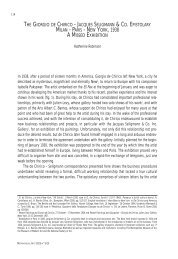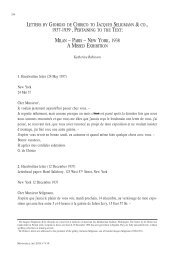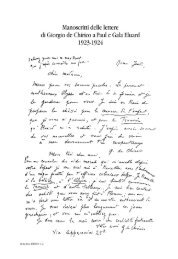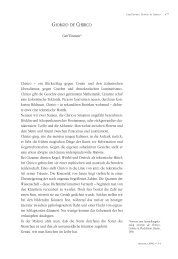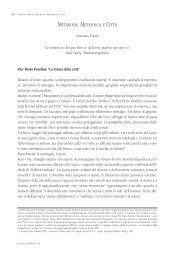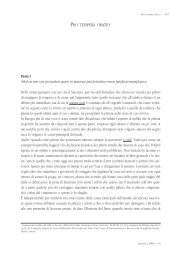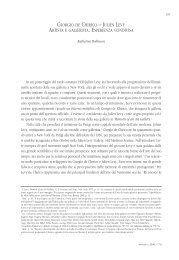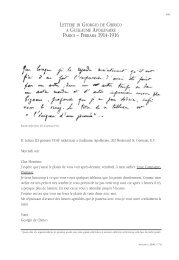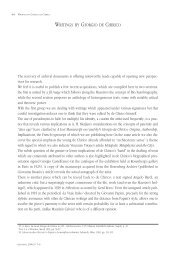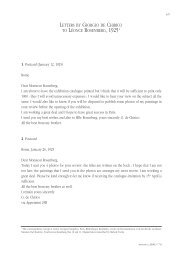293-356_08_Robinson ok.qxp - Fondazione Giorgio e Isa de Chirico
293-356_08_Robinson ok.qxp - Fondazione Giorgio e Isa de Chirico
293-356_08_Robinson ok.qxp - Fondazione Giorgio e Isa de Chirico
You also want an ePaper? Increase the reach of your titles
YUMPU automatically turns print PDFs into web optimized ePapers that Google loves.
350KATHERINE ROBINSON: GIORGIO DE CHIRICO – JULIEN LEVY. ARTIST AND ART DEALER. SHARED EXPERIENCEas “around fifty, gray-haired, has large features, and lo<strong>ok</strong>s quite typically Italian” comes the specificationthat “what makes him all the more <strong>de</strong>sirable in New York… is that he is a single man”. 99Another newspaper reported that <strong>de</strong> <strong>Chirico</strong> remained incognito prior to the exhibition opening andhad “told ship reporters he was a wine merchant”. 100Of the twenty-one paintings on exhibit at the Julien Levy Gallery 101 , the reviews remarked onsubject matter with which the public was already familiar: improvisations on classical Greek themeswith br<strong>ok</strong>en columns, to which the artist had given new form, and his horses, which had acquired acareful and profound painterly ren<strong>de</strong>ring, bringing to mind Delacroix and Rubens. Automatons withegg-shaped heads and romantic landscapes are among the works presented, along with two wellconstructed youthful self-portraits. Attention is <strong>de</strong>dicated to the new fantastic figures of bathers aswell as the gladiator theme, to which he “has given a fresh turn”. 102 Martha Davidson’s article, entitledThe New <strong>Chirico</strong>: a Classic Romantic 103 will be remembered as an important account of the event.Published in “Art News” on November 28 th , Davidson’s article presents a distinct and informative critiqueon the evolution of <strong>de</strong> <strong>Chirico</strong>’s oeuvre, with fundamental references regarding the MysteriousBaths theme, which she evi<strong>de</strong>ntly gathered in a direct dialogue with the artist. According to Davidson,<strong>de</strong> <strong>Chirico</strong>’s canvases show the compatibility between two expressions: “each an escape from reality,the one into a different logic of a dream world, the other into the enchantment of an i<strong>de</strong>alizedreality. / The etherized solitu<strong>de</strong> which <strong>de</strong> <strong>Chirico</strong> ev<strong>ok</strong>ed in his paintings done roughly between1910 and 1920 has completely vanished from these new canvases. […] The paintings in a series calledMysterious Bathing are curious and puzzling. Like all <strong>de</strong> <strong>Chirico</strong>’s recent metaphysical paintings, theymaintain the nostalgic mystery which perva<strong>de</strong>d his early works.” An article published on November15 th in “Art Digest” examines the subconscious aspect inherent in <strong>de</strong> <strong>Chirico</strong>’s painting, seen mostnotably in the Mysterious Baths theme and in the Horses, which are plausibly the kind of horses “thatcan be dreamed” and are “Proud narcistic creatures, luxuriantly maned”. The author notes that <strong>de</strong><strong>Chirico</strong> “extracts something universal from the highly personal realm of inner feelings”, which heexpresses in his “refreshing, clean color, and in the drama of the combative lines, now vertical, nowhorizontal, sometimes parallel, often flame-like” (fig. 9 Horses of the Hellespont, 1935ca). The articleends on this note: “Jerome Bosch, the old Fleming, solved Surrealism but not all of the elements inthe work of <strong>de</strong> <strong>Chirico</strong>, ultra-mo<strong>de</strong>rn who sees with antique eyes”. 104The variegated collection of works on show encouraged one reviewer to comment in a ratherblasé note that the ti<strong>de</strong> seemed to have turned “against the French extremists: such a show as this of<strong>de</strong> <strong>Chirico</strong>’s recent work recalls to us that a return of the ti<strong>de</strong> may bring in with it some very dubi-99De <strong>Chirico</strong> separated from his first wife Raissa in 1930, at the same time he began his relationship with <strong>Isa</strong>bella Pakszwer, whom he married in 1946.<strong>Isa</strong>bella joined <strong>de</strong> <strong>Chirico</strong> in New York in mid-November, creating a situation which caused some confusion regarding his marital status, as <strong>Isa</strong>bellawas mistaken for his wife by a number of people.100Unsigned article in “New York Woman”, November 4, 1936.101Paintings listed in the exhibition catalogue: 1. Alexandros*, 2. Self-portrait, 3. The Artist and his Mother, 4. 5. 6. and 7. Mysterious Bathing, 8. ColonialMannequins, 9. 10. 11. Horses of the Hellespont, 12. Bucephalos, 13. The Rebel, 14. Picador, 15. and 16. Flying Phantom, 17. The Artist in his Studio, 18.The Noble and the Shopkeeper, 19. Dioscures, 20. Heroic Combat, 21. Horses of Tragedy*. *Lent by The Barnes Foundation, Merion, PA.102Unsigned article, “New York Post”, October 31, 1936.103Martha Davidson, The New <strong>Chirico</strong>: A Classic Romantic in “Art News”, November 28, 1936.104Unsigned article, Surrealism Makes its Bow in New York, in “Art Digest”, n. 11, November 15, 1936.METAFISICA 20<strong>08</strong>|N° 7-8



